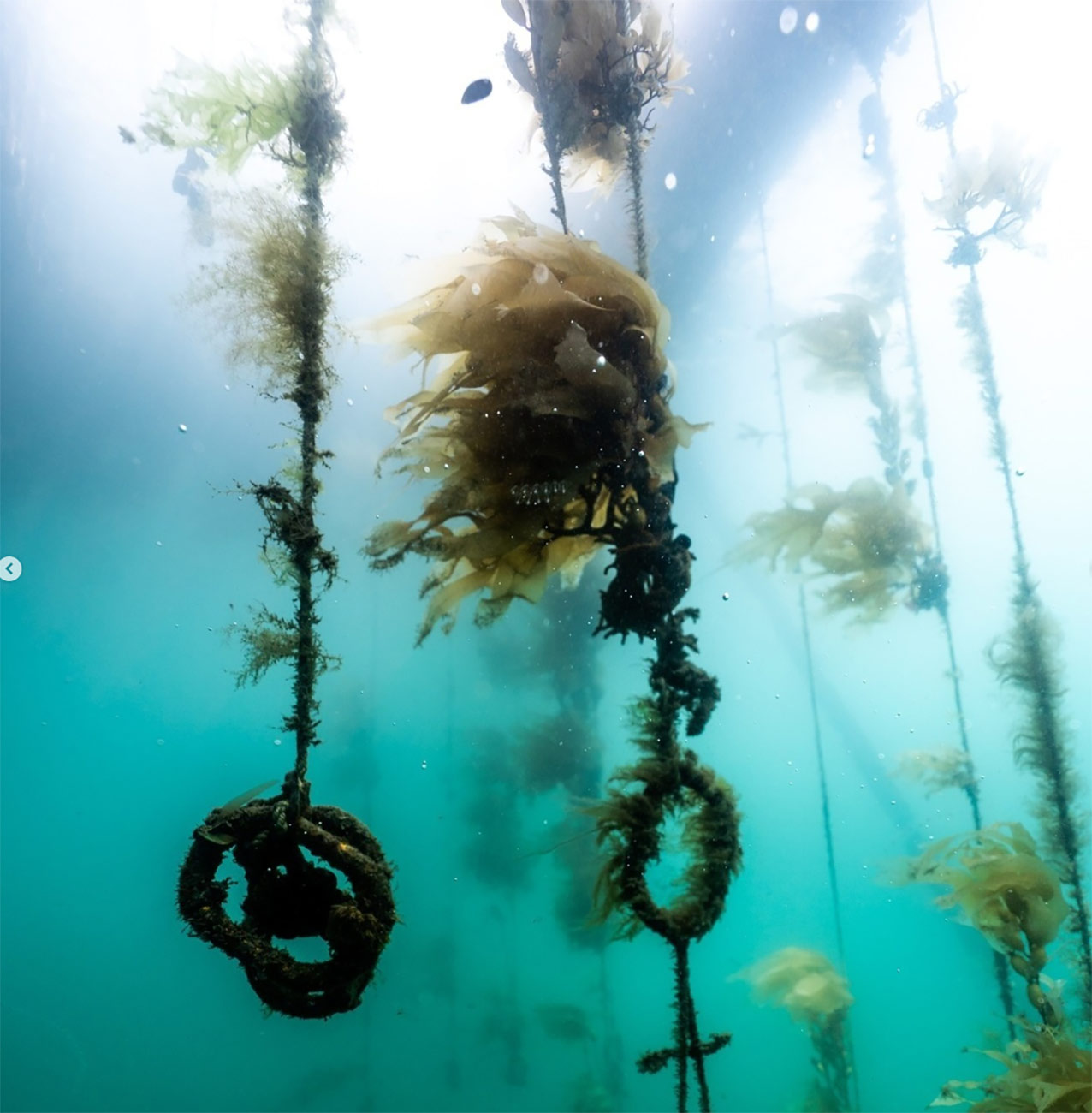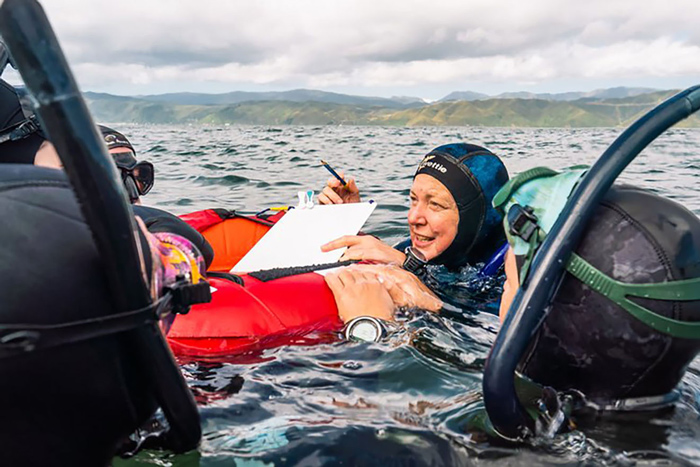
Help for Kelp
This winter, baby giant kelp is being planted into Wellington Harbour / Te Whanganui-a-Tara, where great seaweed forests once thrived.
By Gabi Lardies
As much as the capital is windswept hills, it is also a harbour — those dark, cold waters and all they hold. Under the surface, much has changed as the city has grown. It was once home to an abundance of seaweed forests — diverse ecosystems presided over by the rippling fronds of giant kelp (Macrocystis pyrifera). But divers have seen the kelp forests give way to underwater deserts — bare rocks stripped of life. Similar deserts have been observed elsewhere, including the Hauraki Gulf, Tasmania and San Francisco. They are, at least partly, a result of what scientists call a “trophic cascade”. In Wellington, it is thought that overfishing of snapper, crayfi sh and blue cod has resulted in exploding populations of their prey — kina. Free of their predators, the spiny creatures have eaten a lot of kelp, in some areas all of it, right down to the rock. Then, they starve — fishermen and scientists who break open kina from these barrens find them almost empty inside — the yellow roe tiny and shrivelled.
Kelp faces other threats: rising water temperatures, sedimentation, sand inundation, coastal development, and pollution. For divers witnessing the kelp’s disappearance, it was like seeing trees in the city’s green belts fall, with no saplings replacing them. Some were motivated to alert other Wellingtonians to what was happening to the “blue belt” of the harbour.
Zoe Studd has been one of these underwater people since primary school. Her dad would bunk off early from work, pick her up, and take her snorkelling around Makara, on Wellington’s west coast. Today, Studd wears her grey hair long and has “about a bazillion things on the go”, mostly related to marine conservation. She’s the project lead for Love Rimurimu, a restoration project which brings together researchers, divers, iwi and seaweed lovers. It was born in 2020 as an educational project. Participants in guided community snorkelling expeditions soon started asking, “what can we do? How can we restore the kelp forests?”

At Mahanga bay, the fi rst cohort of lab grown kelp attached to weighted ropes and grew well. As well as monitoring the kelp, light and temperature were recorded. Measuring environmental conditions allows researchers to identify what leads to optimal growth. Photo: Supplied
First, spore has to be collected from kelp growing in the wild. Divers don their wetsuits, masks and tanks, and head to the base of the kelp. Just above the holdfast, blades about a forearm long and a couple of fi ngers wide, cluster on the stems. These produce male and female spores, which are held in dark raised ridges. The divers collect these, and take them to a specialised laboratory and nursery set up at the National Institute of Water and Atmospheric Research (NIWA) in Wellington.
This is where marine biologist and macroalgae specialist Roberta D’Archino has taught the restoration team everything they need to know to reproduce algae. D’Archino has dedicated herself to macroalgae in New Zealand for the past 15 years, contributing over a thousand scientifi c specimens — dried, mounted and categorised — to Te Papa’s collections.
The kelp blades are washed, dried, cut into confetti like strips, and layered into plastic containers between paper towels. After a dry, cold night in the fridge, the kelp is placed in sterilised seawater, a process that encourages the release of spores. Cleanliness is important.
“One of the trickiest things about spore collection is keeping everything as contaminant-free as you can,” Studd says. “Seawater is filled with life, and you don’t want a whole lot of bacteria and other things growing. You only want to grow kelp — so you have to minimise everything else.”
The water becomes what Studd calls “spore slurry”. Peering into a microscope, D’Archino can see individual spores that look almost like bubbles. Some dart around, bumping into other spores, forming clusters or moving off in another direction. They are very much alive.
The next stage is to give the spores something to grow on — a substrate. Rocks and string are added to the spore slurry. Within a month, they have “very cute little baby seaweeds” growing from them, Studd says. Spores even appear on the mesh used to line the tanks.
When the baby kelp are about two months old and two centimetres long, they are ready to be transferred into the ocean. “It’s a very exciting time,” Studd says. In September last year, kelp was planted at a test site in Mahanga Bay, Miramar. String covered in the young kelp was wound around ropes, which were suspended from an anchored raft. Seaweed-covered rocks were either dropped to the seafloor or suspended in cages, for protection from hungry kina.
Over the next six months, the kelp on string grew from two centimetres to two metres. But substrates are still on trial. Though the string and ropes have worked well, both are made of synthetic material. “For restoration projects when you put a support in, you actually want it to break down naturally over time,” Studd says. “You want to get to a point where no-one knows you were there in the first place, because the original substrates have broken down and just the seaweed remains.” Though rocks would seem to fit the bill for substrate, much of the kelp they carried was bashed off by wave action.

In March at Worser Bay, Wellington, Zoe Studd taught a team of volunteers, the kelpers, methods they will use to monitor the growth and health of kelp at the five pilot sites. Photo: Supplied
The iwi involved in Love Rimurimu, Taranaki Whānui, are finding ways to work with traditional materials such as harakeke and tī kōuka. These are strong fibres, woven for generations, and could provide a perfect alternative to nylon string and rope. In the lab, different substrates are being trialled, including wool, sponge and lattices of corn starch.
In some ways, the success of the trial at Mahanga Bay was not unexpected. Giant kelp is the fastest growing organism on the planet — it can grow up to 50 centimetres a day. And there is already an established population of kelp in the bay — proof it’s a habitable environment. Other areas of the harbour may not be so kelp-friendly. Love Rimurimu is choosing five new restoration sites for plantings this winter.
In February, it pledged to contribute to the Global Kelp Forest Challenge — an ambitious goal to restore a million hectares of kelp forest by 2040. For now, the Wellington organisation has pledged to restore one hectare of giant kelp in Wellington Harbour. “It’s quite an ambitious target for the harbour, because if you take out the shipping channel, the sediments at the mouths of rivers, and you hone down to rocky reefs, there’s not that much left,” Studd says. “We’ll probably fail more than we succeed initially.” Still, it’s a goal she hopes to reach by 2025.
In the short term, the kelp will do what it does best — grow. But there’s another looming challenge: climate change, the elephant in every restoration room. In New Zealand, Wellington is the northernmost limit for giant kelp, and waters are warming. Already vast swathes of giant kelp have been decimated by marine heat waves, “they roll through, and you can lose the whole stand,” Studd says. Spore collection is tactical, with divers focusing on gathering from plants which have survived heat waves, but this may not be enough. “It might be that macrocystis doesn’t survive inside the harbour in the years to come,” Studd says. “It’s something we need to consider. What’s the succession?”
The value of attempting to restore these forests might not be the forests themselves. As the project learns from their trials and failures, a blueprint of kelp restoration is being sketched out. There’s a process being cultivated which could be applied elsewhere — south, east, or west. Studd knows it’s important this toolkit be shared with others, both here and overseas. For now, this knowledge grows in plastic tubs, watched over by D’Archino through the lens of her microscope.
Gabi Lardies is North & South’s junior staff writer, a role supported by NZ On Air’s Public Interest Journalism.

This story appeared in the June 2023 issue of North & South.
